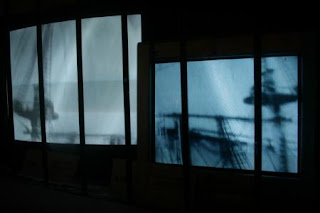
New work by / Nathan Pohio /
Altron TV Services
Corner Cranford and Westminster Streets, Christchurch
Text by Thomasin Sleigh, Harold Grieves and Judith Carnaby
During the first weeks of October 2007, Nathan Pohio showed a new video work in the windows of a suburban television repair store. Facilitated by HSP’s offsite initiatives, Pohio made use of the pre-existing monitors in the windows of the Altron TV Services, located on the corner of Cranford and Westminster Streets in Christchurch. Based on a lenticular print, Pohio’s film showed a multiplied and fragmented version of an original photographic image depicting a colonial sailing ship surging through the ocean. It also tentatively evoked new conversations between different modes of view. After all some viewers will walk past the work everyday, and others will see it only once, and of course Pohio’s work is a constantly changing artwork; different at each visiting experience.
The lenticular print has been the starting point for a number of recent works by Pohio. Last year, he showed numerous variations of a video he’d made based on lenticular picture of a group of horses. Using a tracking shot to set in motion the reflective surface, its almost holographic potential allowed Pohio to play a kind of optical trick that enticed the horses not into animation but rather an odd, oxymoronic static-linear flow. Worked as a profile reproduction, the filming set in motion a sedentary horse by altering the reflective and alternating point-of-view that the lenticular image imposes on its audience. This multiplicity of views is further manipulated by Pohio’s camera work, which glides across the reflective surface and lends the optical conjuring of a sense of momentum. In this new series of work, Pohio picks apart the technological mediation of travel and its unravelling through the cinematic gaze, shifting effortlessly from horse to sailing vessel.
Shifting, constantly changing and blurred, Pohio’s latest work dips and dives over the static image, evoking a sense of the illusory and transitory motion of imagination itself and in doing so draws the viewer into its dreamlike quality. Pohio’s interest in the process of filmmaking is evident in this work. The short film reveals and responds to the tricks, manipulation and construction evident in cinema processes. Questioning and probing, the work explores notions of depth and multiplicity in pictorial space, and Pohio’s placement of the images in separate screens reinforces the split perspectives and changing visual qualities of the film itself. Playing with the picture plane and changing the field of vision to create an atmosphere of ghostliness and confusion, Pohio’s work encourages a malleable perception, and raises awareness of how film is intended to make you react, think and behave.
Caught in full motion, with no start or stop, just an iris lens fade that ends and begins with the video’s loop, the ship’s motion becomes an exaggerated, even bloated filmic action. Tumultuous and indifferent, it is a kind of stoic image of movement. Monolithic in scope and arrogant in its encompassing terrain, the ship takes centre-stage, triumphant in its momentum and somewhat overburdened by its performance. Reinforced by the disjointed and fractured views which washing through the blur of the camera’s jutting/flitting over the reflective surface of the source material, the motion is distended, tracked and paced out, beckoning with its prowling visitation rites.
Of course a ship is never just a ship, but it’s not always necessary to overburden content with interpretation. It would be too easy to slip into a convenient rhetoric of colonial arrival but this doesn’t go far enough. Nor will you find much consolation in its corollary with the neotenic renditions of the grotesque in Disney’s The Pirates of Caribbean. Rather what seems to be at stake in Pohio’s work is the fairly rudimentary conventions of imagination itself. It may be better then to call Pohio’s films a kind of somnambulistic luring, which having salvaged their source material from the obsolescent trinket pile have finally gifted the lenticular print the kind of cinematic animation they have always promised.
In seeking new avenues for presenting his work and placing it in a suburban area, Pohio has extended the poignancy and immediacy of his ideas. Divorced from the realm of the gallery and appearing briefly in a store window in St. Albans, this work becomes all the more illusory, mysterious and fleeting.






